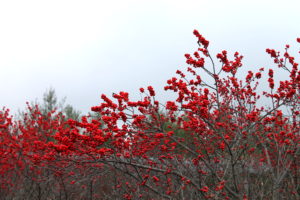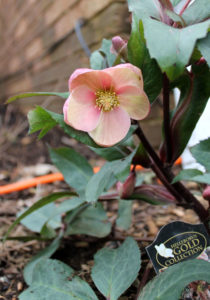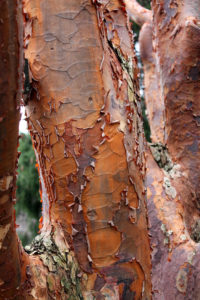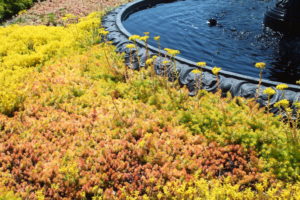Top 12 Plants for Winter Interest
Now that winters aren’t always snow-covered from wire to wire like they so often used to be, plants that look good in winter play a more important role.
Here are 12 of my favorites:
1.) Winterberry holly. Easily my favorite for the bright-red, pea-sized berries that form on females in fall, then hang around until the birds finally eat them in mid to late winter. Apparently, they’re not high on birds’ taste list, despite being native shrubs.
The trick is that you’ll need a compatible male to pollinate the proper female, so match carefully (i.e. ‘Winter Red’ with ‘Southern Gentleman,’ Red Sprite® with ‘Jim Dandy,’ ‘Scarlett O’Hara’ with ‘Rhett Butler,’ etc.) Winterberries range in size from about 5- to 6-footers up to 10-footers.
For evergreen hollies, which also get nice fruits in winter, give me the upright Red Beauty®, a slow-grower that’s great for house corners, or ‘Blue Princess,’ one of the best bushy types for property borders. Sun or part shade.
2.) Red-twig dogwood. Red branches are the attraction here. They get redder in winter and have their best color when you cut back the whole bush to a few inches at the end of each winter to encourage all-new wood each year.
Most are native shrubs and grow around 5 to 6 feet tall and wide. ‘Midwinter Fire,’ ‘Cardinal’ and Red Rover™ are three especially nice varieties. Sun or part shade.
3.) Nandina. Warmer winters make this southern-staple, broadleaf evergreen a better bet than ever. Some, like ‘Compacta’ and ‘Gulfstream,’ are more upright to 4 or 5 feet tall with clusters of red winter fruits, while others, like ‘Firepower’ and ‘Woods Dwarf,’ are dwarf, 3-footers that don’t fruit but that turn brilliant red over winter. Sun to shade.
4.) Snowdrops. These little bulbs are about the earliest bloomers you’ll find, often poking up as early as end of January or already in flower as a mid-winter snow melts.
Snowdrops grow only 3 or 4 inches tall and have white, hanging, bell-shaped flowers. Plant them in October, and they’ll colonize over the years since rodents seldom bother them. Sun or part shade.
5.) Hellebores. A few perennials keep their foliage all winter, but hardly any bloom before spring shows up. Hellebores do both – especially the Christmas rose type (Helleborus niger), which I’ve had blooming in my yard on New Year’s Day. ‘Pink Frost’ is one of my favorite varieties.
Flowers can be white or pink and usually droop down like a hanging bell, although some varieties hold their flowers more horizontally.
6.) Stewartia. Several trees have peeling, flaking or mottled bark that stands out particularly nice in winter, but I like the look of Japanese and Korean stewartias as well as any. As trees age, bark flakes off to give the trunks a sort of Dalmatian-like appearance.
Stewartias also get white camellia-like flowers in early summer and put on some of the most brilliant fall-foliage shows in fall in addition to the bark. They grow slowly to about 20 feet and 15 wide in 20 to 25 years. Sun or part shade.
7.) River birch. Not far behind stewartia in the bark-interest department is this native tree with the cinnamon-colored peeling bark. River birches look best when allowed to grow three trunks.
These are fairly fast-growing trees that do well in damp soil and have leaves that turn yellow in fall. They’re also much more resistant to borers than white birch. Sun or part shade.
8.) Paperbark maple. A third tree that’s super-impressive for its bark is this slow-growing, mid-size maple that has a mahogany/cinnamon color to its peeling bark. The leaves are a nice red/gold in fall, too. Figure 25 to 30 feet tall in 25 years. Sun or light shade.
9.) Japanese maple. These small, slow-growing trees have a lot going for them – not the least of which is the elegant branching structure that’s visible once the leaves drop in late fall. Even as textural as the leaves are, this is a species that’s just as nice bare in winter as clothed in summer.
I especially like the red, cut-leafed, dwarf types, either weepers like ‘Tamukeyama’ or ‘Crimson Queen’ or more upright ones like ‘Beni Otaki’ and ‘Shojo Nomura.’ These do best in a site with some sun protection in summer and winter-wind protection in winter.
10.) Goldthread falsecypress ‘Golden Mop.’ I could list lots of conifers for their colorful and textural evergreen foliage, but I like this fairly common variety of falsecypress (Chamaecyparis pisifera) best for its shaggy habit and narrow, golden foliage.
These are tough in heat, cold, drought and fairly poor soil and grow about 6 feet tall and wide. Best in full sun or light shade.
11.) Creeping sedum ‘Angelina.’ My favorite sunny groundcover, this creeper not only gives a golden carpet all summer but stays evergreen and turns a red/gold shade over winter before “golding” back up in spring.
Grows only about 3 inches tall, has narrow, succulent leaves, and isn’t bothered by anything other than soggy, wet soil. Best in full sun.
12.) Witch hazel. This tall shrub is the first of the season to bloom, usually unfurling its spidery flowers of yellow, gold, orange or red as winter heads into its final third. Witch hazels typically grow 10 to 15 feet tall and add fiery fall foliage to its early flowering.
‘Jelena’ (coppery/orange flowers) and ‘Arnold’s Promise’ (yellow flowers) are two of my favorites. Sun or part shade.












